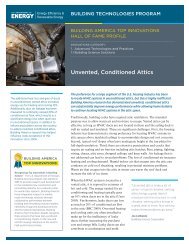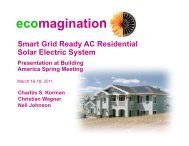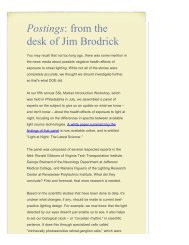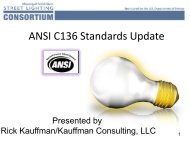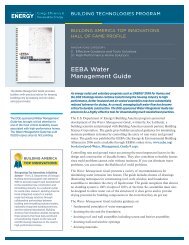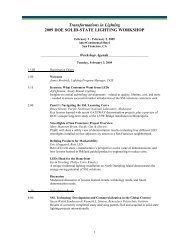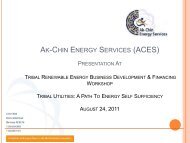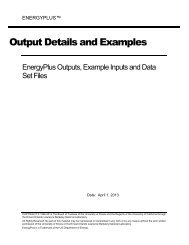Improving the Efficiency of Your Duct System - EERE - U.S. ...
Improving the Efficiency of Your Duct System - EERE - U.S. ...
Improving the Efficiency of Your Duct System - EERE - U.S. ...
Create successful ePaper yourself
Turn your PDF publications into a flip-book with our unique Google optimized e-Paper software.
OFFICE OF BUILDING TECHNOLOGY, STATE AND COMMUNITY PROGRAMS<br />
ENERGY EFFICIENCY AND RENEWABLE ENERGY • U.S. DEPARTMENT OF ENERGY
Table <strong>of</strong> Contents page<br />
Introduction . . . . . . . . . . . . . . . . . . . . . .1<br />
Components <strong>of</strong> <strong>the</strong> <strong>Duct</strong> <strong>System</strong> . . . . .2<br />
Energy Losses and Costs . . . . . . . . . . .2<br />
Health Hazards . . . . . . . . . . . . . . . . . . .7<br />
Inspection <strong>of</strong> <strong>the</strong> <strong>Duct</strong> <strong>System</strong> . . . . . . .7<br />
Tell-Tale Signs <strong>of</strong> Problem <strong>Duct</strong>s . . . . . .9<br />
Get a Pr<strong>of</strong>essional! . . . . . . . . . . . . . . .10<br />
Opportunities in New Homes . . . . . . . . .11<br />
For Fur<strong>the</strong>r Information . . . . . . . . . . . .12<br />
DISCLAIMER<br />
This report was prepared as an account <strong>of</strong> work sponsored by an agency <strong>of</strong> <strong>the</strong> United States Government. Nei<strong>the</strong>r <strong>the</strong> United States Government nor any agency <strong>the</strong>re<strong>of</strong>, nor<br />
any <strong>of</strong> <strong>the</strong>ir employees, makes any warranty, express or implied, or assumes any legal liability or responsibility for <strong>the</strong> accuracy, completeness, or usefulness <strong>of</strong> any information,<br />
apparatus, product, or process disclosed, or represents that its use would not infringe privately owned rights. Reference herein to any specific commercial product, process, or service<br />
by trade name, trademark, manufacturer, or o<strong>the</strong>rwise does not necessarily constitute or imply its endorsement, recommendation, or favoring by <strong>the</strong> United States Government<br />
or any agency <strong>the</strong>re<strong>of</strong>. The views and opinions <strong>of</strong> <strong>the</strong> authors expressed herein do not necessarily state or reflect those <strong>of</strong> <strong>the</strong> United States Government or any agency <strong>the</strong>re<strong>of</strong>.
THE DUCT SYSTEM, used in air heating and air cooling your home,<br />
is a collection <strong>of</strong> tubes that distributes <strong>the</strong> heated or cooled air to<br />
<strong>the</strong> various rooms. This system can make a big difference in both<br />
<strong>the</strong> cost and <strong>the</strong> effectiveness <strong>of</strong> heating and cooling <strong>the</strong> home.<br />
The duct system can have an important effect on health <strong>of</strong><br />
<strong>the</strong> occupants through <strong>the</strong> distribution <strong>of</strong> indoor air pollution.<br />
Changes and repairs to a duct system should always be performed<br />
by a qualified pr<strong>of</strong>essional.<br />
This brochure is meant to help you understand <strong>the</strong> problems that<br />
can affect <strong>the</strong> duct system and how you can:<br />
• Save money<br />
• Improve comfort<br />
• Protect health<br />
Individual<br />
Branch<br />
<strong>Duct</strong>s<br />
Riser<br />
In-line<br />
Dampers<br />
Return Plenum<br />
Trunks<br />
Risers<br />
Furnace<br />
Panned<br />
Individual<br />
Branch<br />
<strong>Duct</strong>s<br />
Furnace<br />
Figure 1. A Common <strong>Duct</strong> <strong>System</strong><br />
Supply Plenum<br />
Registers<br />
SUPPLY SYSTEM<br />
RETURN SYSTEM<br />
Registers using<br />
Wall Cavities as <strong>Duct</strong>s<br />
1
2<br />
COMPONENTS OF THE DUCT SYSTEM<br />
A duct system is a branching network <strong>of</strong> round<br />
or rectangular tubes — generally constructed <strong>of</strong><br />
sheet metal, fiberglass board, or a flexible plasticand-wire<br />
composite — located within <strong>the</strong> walls,<br />
floors, and ceilings. Usually, you can see only <strong>the</strong><br />
outlet, which is a register covered with grillwork.<br />
Figure 1 shows a common type <strong>of</strong> duct system.<br />
This system consists <strong>of</strong> supply ducts and return ducts.<br />
Central heating or cooling equipment (furnace, air<br />
ENERGY LOSSES AND COSTS<br />
Typical duct systems lose 25 to 40 percent <strong>of</strong> <strong>the</strong><br />
heating or cooling energy put out by <strong>the</strong> central<br />
furnace, heat pump, or air conditioner. Homes<br />
with ducts in a protected area such as a basement may<br />
lose somewhat less than this, while some o<strong>the</strong>r types<br />
<strong>of</strong> systems (such as attic ducts in hot, humid climates)<br />
<strong>of</strong>ten lose more.<br />
<strong>Duct</strong> repairs could be <strong>the</strong> most important energy<br />
improvement measure you can do if your ducts are in<br />
<strong>the</strong> attic. If only one half <strong>the</strong> typical loss <strong>of</strong> uninsulated<br />
and unsealed ducts that are in attics or crawl spaces<br />
were saved, it would amount to $160 <strong>of</strong>f <strong>the</strong> total heating<br />
and cooling bill in a typical home. This savings is<br />
based on <strong>the</strong> national average use <strong>of</strong> natural gas and<br />
electricity for central heating and cooling at national<br />
average energy cost <strong>of</strong> 70 cents per <strong>the</strong>m, and 8 cents<br />
per kilowatt-hour. With <strong>the</strong>se savings, <strong>the</strong> cost to seal<br />
and insulate <strong>the</strong> ducts would most likely be paid for<br />
after three years. These estimates apply to retr<strong>of</strong>itting<br />
conditioner, or heat pump) contains a fan that forces<br />
heated or cooled air into supply ducts leading to <strong>the</strong><br />
rooms. The fan gets its air supply through return ducts,<br />
which in <strong>the</strong> best systems are installed in every room<br />
<strong>of</strong> <strong>the</strong> house. To save on installation costs, most homes<br />
have one or two return registers located in common<br />
areas such as hallways. (Some homes have no return<br />
duct systems. Such design shortcuts <strong>of</strong>ten result in<br />
lower efficiency and higher heating and cooling bills.)<br />
an existing home. For new construction more <strong>of</strong> <strong>the</strong><br />
ductwork would be accessible to <strong>the</strong> installer and <strong>the</strong><br />
potential savings would be greater; and with lower cost<br />
to install sealant and insulate, <strong>the</strong> payback would be<br />
less than one year.<br />
<strong>Duct</strong> systems lose energy in two ways: by conduction<br />
<strong>of</strong> heat from <strong>the</strong> warm surface, and air leakage through<br />
small cracks and seams. For simplicity, we’ll talk about<br />
warm air for heating, but <strong>the</strong> same information applies<br />
to cooling when <strong>the</strong> air conditioner is on.<br />
Conduction<br />
One way duct systems lose energy is for <strong>the</strong> warm air<br />
inside <strong>the</strong> ducts to heat <strong>the</strong> duct walls, which in turn<br />
heat <strong>the</strong> cold air outside <strong>the</strong> ducts. If <strong>the</strong> ducts are in<br />
an attic or vented crawl space that is nearly as cold as<br />
<strong>the</strong> outdoors, this heat is completely lost. If <strong>the</strong> ducts<br />
are in a basement, some <strong>of</strong> <strong>the</strong> heat lost from <strong>the</strong> ducts<br />
may be recaptured by warming <strong>the</strong> basement ceiling<br />
enough to reduce <strong>the</strong> heat lost from <strong>the</strong> house.
ENERGY LOSSES AND COSTS<br />
Air Leakage<br />
Ano<strong>the</strong>r way that ducts lose energy is through air leakage.<br />
Sometimes this leakage is from accidental holes in<br />
<strong>the</strong> ducts or poorly connected duct sections; but even if<br />
<strong>the</strong> ducts are sealed, <strong>the</strong>ir operation can cause <strong>the</strong> house<br />
itself to leak more air than would o<strong>the</strong>rwise be <strong>the</strong> case.<br />
An understanding <strong>of</strong> pressure differences in <strong>the</strong> duct<br />
system helps to better understand air leakage in <strong>the</strong><br />
home. Air moves from high pressure to low pressure.<br />
To get air to move from <strong>the</strong> supply duct into <strong>the</strong> room it<br />
serves, <strong>the</strong> air in <strong>the</strong> duct has to be at a higher pressure<br />
than <strong>the</strong> air in <strong>the</strong> room. Similarly, to move air from <strong>the</strong><br />
room into <strong>the</strong> return duct, <strong>the</strong> air in that duct has to be at<br />
a lower pressure than <strong>the</strong> air in <strong>the</strong> room. The registers<br />
Return duct at<br />
low (-) pressure<br />
living space, neutral pressure<br />
furnace<br />
fan<br />
buffer space, neutral pressure<br />
Figure 2. Ideal <strong>Duct</strong> Schematic - No Leakage<br />
are <strong>the</strong> openings through which this air is intended to<br />
move. The duct walls provide <strong>the</strong> barriers that prevent<br />
air from moving where we don’t want it to go.<br />
The fan <strong>of</strong> <strong>the</strong> central furnace creates <strong>the</strong>se pressure<br />
differences. When <strong>the</strong> fan stops, <strong>the</strong>se pressures quickly<br />
equalize and <strong>the</strong> flow <strong>of</strong> air through <strong>the</strong> duct stops, too.<br />
Figure 2 shows a duct system that does not leak. The<br />
furnace fan produces a high pressure in <strong>the</strong> supply ducts<br />
and a low pressure in <strong>the</strong> return ducts. The high pressure<br />
forces warm air from <strong>the</strong> supply ducts to flow into <strong>the</strong><br />
rooms, and low pressure draws room air back into <strong>the</strong><br />
return ducts.<br />
Supply duct at<br />
high (+) pressure<br />
Note: buffer<br />
space is typically<br />
an attic, basement,<br />
or crawlspace.<br />
3
4<br />
ENERGY LOSSES AND COSTS<br />
Air leakage from outside<br />
into living space<br />
Return duct,<br />
sealed<br />
Leaky Supply <strong>Duct</strong>s<br />
Figure 3 shows perhaps <strong>the</strong> simplest example <strong>of</strong> duct<br />
leakage. Here <strong>the</strong> supply ducts leak, but <strong>the</strong> return ducts<br />
are air tight. Even though half <strong>the</strong> duct system is good,<br />
two bad things still happen. First, some <strong>of</strong> <strong>the</strong> air that<br />
has just been warmed by <strong>the</strong> furnace is lost. Second,<br />
this air has to be replaced. If it isn’t, <strong>the</strong> house would<br />
soon be pumped down to a vacuum, and we know that<br />
doesn’t happen. What does happen is that cold air from<br />
<strong>the</strong> outside is drawn into <strong>the</strong> house through cracks and<br />
living space at negative pressure<br />
furnace<br />
fan<br />
buffer space, neutral pressure<br />
Figure 3. <strong>Duct</strong> <strong>System</strong>s With Supply Side Leaks<br />
Supply duct leakage<br />
is made from outside<br />
air leaking into house<br />
Supply duct<br />
leakage<br />
small holes in <strong>the</strong> outside walls. Usually <strong>the</strong>se occur<br />
around doors and windows. Some houses have more <strong>of</strong><br />
<strong>the</strong>se than o<strong>the</strong>rs, but no house is air tight. So we’ve<br />
lost some <strong>of</strong> <strong>the</strong> hottest air in <strong>the</strong> house (air that just<br />
came from <strong>the</strong> furnace), and replaced it with <strong>the</strong> coldest<br />
air around (air from <strong>the</strong> outside). In o<strong>the</strong>r words, a leaking<br />
supply duct is an energy loser in two ways: <strong>the</strong><br />
energy loss that does not go to <strong>the</strong> rooms, and <strong>the</strong> extra<br />
energy needed to heat cold air that leaked into <strong>the</strong> house.
ENERGY LOSSES AND COSTS<br />
Leaky Return <strong>Duct</strong>s<br />
Suppose <strong>the</strong> supply ducts are tight but <strong>the</strong> returns<br />
leak, as shown in Figure 4. The return duct is at a low<br />
pressure— lower than <strong>the</strong> house or <strong>the</strong> outside — so<br />
cold air from <strong>the</strong> outside is pulled into this duct. This<br />
cold air is heated in <strong>the</strong> furnace (along with air that<br />
came from <strong>the</strong> house through <strong>the</strong> return registers).<br />
The amount <strong>of</strong> air delivered to <strong>the</strong> house by <strong>the</strong> supply<br />
registers is greater than what <strong>the</strong> return ducts took from<br />
Excess air leakage from<br />
<strong>the</strong> living space<br />
Return duct,<br />
(low pressure)<br />
drawing air from<br />
buffer space<br />
Possibility <strong>of</strong><br />
drawing<br />
unwanted<br />
gasses from<br />
buffer space<br />
into ducts<br />
living space at positive pressure<br />
furnace<br />
fan<br />
buffer space, neutral pressure<br />
Figure 4. <strong>Duct</strong> <strong>System</strong> with Return Side Leaks<br />
<strong>the</strong> house (<strong>the</strong> difference being <strong>the</strong> cold air that leaked<br />
into <strong>the</strong> return ducts). To equalize <strong>the</strong> flows, heated<br />
room air leaks out <strong>of</strong> <strong>the</strong> house through <strong>the</strong> same holes<br />
and cracks that, in <strong>the</strong> previous example, allowed air to<br />
leak in. So cold air is pulled in and warm air leaks out.<br />
In addition to creating energy losses, leaky return ducts<br />
can create health problems (see below).<br />
Supply duct leakage<br />
is made from outside<br />
air leaking into house<br />
Supply duct<br />
sealed<br />
5
6<br />
ENERGY LOSSES AND COSTS<br />
Zone Pressurization<br />
<strong>Duct</strong>s can cause air leakage in <strong>the</strong> house even if nei<strong>the</strong>r<br />
<strong>the</strong> supply nor <strong>the</strong> return ducts leak <strong>the</strong>mselves. Figure<br />
5 shows how this can happen. Imagine that a home has<br />
a return register in one room but no supply (<strong>the</strong> room on<br />
<strong>the</strong> left in Figure 5), and a supply register in ano<strong>the</strong>r<br />
room but no return. Now close <strong>the</strong> door between <strong>the</strong>se<br />
rooms. The room with <strong>the</strong> supply duct (<strong>the</strong> room on <strong>the</strong><br />
right in Figure 5) will have relatively high pressure. The<br />
supply duct will be trying to blow this room up like a<br />
balloon. Similarly, <strong>the</strong> room with <strong>the</strong> return will have<br />
relatively low pressure. So inside air will leak out from<br />
<strong>the</strong> room on <strong>the</strong> right, and outside air will leak into <strong>the</strong><br />
room on <strong>the</strong> left. This places an added load on <strong>the</strong> heating<br />
equipment. The situation described here is somewhat<br />
simplified to show <strong>the</strong> basic idea, but variations <strong>of</strong><br />
Return duct at<br />
low (-) pressure<br />
Air leakage<br />
from outside to<br />
living space<br />
Mild low (-)<br />
pressure<br />
Figure 5. Excess Air Leakage in <strong>the</strong> House<br />
Caused by Isolation <strong>of</strong> Zones<br />
it are common in real homes. Most new homes built today<br />
do not have duct returns in each room. The problem can<br />
be avoided in rooms with no return register and doors<br />
that are <strong>of</strong>ten closed by installing an opening covered<br />
by a louvered grill in <strong>the</strong> door or in <strong>the</strong> adjoining wall.<br />
Energy Losses When <strong>the</strong> Fan Is Off<br />
So far, we’ve been talking about what happens when <strong>the</strong><br />
central furnace fan is running. But even when it’s <strong>of</strong>f<br />
(which is most <strong>of</strong> <strong>the</strong> time) <strong>the</strong> leaks in ductwork add to<br />
<strong>the</strong> air leaks in <strong>the</strong> rest <strong>of</strong> <strong>the</strong> house. The cracks in ductwork<br />
typically have an area that is 10 to 20 percent <strong>of</strong><br />
<strong>the</strong> leakage area <strong>of</strong> <strong>the</strong> house. Over <strong>the</strong> course <strong>of</strong> a heating<br />
season, <strong>the</strong> energy losses from ducts when <strong>the</strong> fan is<br />
<strong>of</strong>f can be nearly as great as when <strong>the</strong> fan is on!<br />
furnace<br />
fan<br />
Mild high (+)<br />
pressure<br />
buffer space, neutral pressure<br />
Air leakage<br />
from living space<br />
to outside<br />
Strong high (+)<br />
pressure
HEALTH HAZARDS<br />
Leakage in <strong>the</strong> duct system can be hazardous to<br />
your health. Especially problematic are leaky returns<br />
in an enclosed space such as a basement or garage that<br />
also contains <strong>the</strong> furnace. This was <strong>the</strong> situation shown<br />
in Figure 4. If <strong>the</strong> return ducts leak, <strong>the</strong>ir low pressure<br />
can pull down <strong>the</strong> pressure in <strong>the</strong> basement or garage as<br />
well, and this can suck flue gases from <strong>the</strong> furnace and<br />
radon gas from <strong>the</strong> soil surrounding <strong>the</strong> home. The flue<br />
gases can be hazardous to health if <strong>the</strong>y contain carbon<br />
monoxide. Exposure to radon gas from <strong>the</strong> ground is <strong>the</strong><br />
second leading cause <strong>of</strong> lung cancer (after smoking).<br />
Although experts disagree about how common <strong>the</strong>se<br />
hazards are, by upgrading <strong>the</strong> energy efficiency <strong>of</strong> <strong>the</strong><br />
duct system you have an opportunity to avoid <strong>the</strong>se<br />
potential problems in your home.<br />
INSPECTION OF THE DUCT SYSTEM<br />
You probably wonder how you can know if your<br />
system is losing large amounts <strong>of</strong> energy. Although<br />
it is <strong>of</strong>ten difficult to be sure without testing, some<br />
tell-tale signs, if present in your duct system, should<br />
make you have it checked by a pr<strong>of</strong>essional.<br />
It will help to make a simple diagram <strong>of</strong> <strong>the</strong> system.<br />
This can be a rough sketch. There is no need for<br />
blueprint quality here.<br />
The first thing you need to do is find <strong>the</strong> central heating<br />
unit. That should be no problem if it is located in a basement.<br />
It is probably something you pass by almost every<br />
day. However, it may be located in an attic or crawl space.<br />
Safety Tips<br />
To get near <strong>the</strong> ducts, you may have to look into spaces<br />
you have never been in before, especially if <strong>the</strong> duct<br />
system is located in an attic or crawl space. Therefore,<br />
be sure to follow common-sense safety rules:<br />
• Guard against falls, cuts, and o<strong>the</strong>r personal injuries.<br />
• Do not open up or probe into any electrical<br />
devices, wires, or connections.<br />
• Wear an approved mask if you go into an area<br />
with fiberglass or loose fill insulation.<br />
• Before you touch any uninsulated duct, hold your<br />
hand about an inch from it to check if it is hot.<br />
This is especially important in furnaces fueled<br />
with gas or oil, because <strong>the</strong> vent pipe that carries<br />
<strong>the</strong> flue gases to <strong>the</strong> chimney looks like a small<br />
duct yet may have a temperature <strong>of</strong> several hundred<br />
degrees Fahrenheit. Generally <strong>the</strong> vent will<br />
be a round sheet-metal pipe about six inches in<br />
diameter that leads upward from <strong>the</strong> furnace<br />
cabinet. (If <strong>the</strong> furnace is one <strong>of</strong> <strong>the</strong> new high<br />
efficiency models, it might be vented horizontally.)<br />
Filters<br />
While you are at it, you might want to locate <strong>the</strong> filter,<br />
which is usually within <strong>the</strong> central fan unit or at <strong>the</strong><br />
return register. The filter removes dust and o<strong>the</strong>r small<br />
particles that o<strong>the</strong>rwise could interfere with <strong>the</strong> operation<br />
<strong>of</strong> <strong>the</strong> blower and <strong>the</strong> furnace heat exchanger. When it fills<br />
up with dust, it cannot do its job and needs to be changed.<br />
7
8<br />
INSPECTION OF THE DUCT SYSTEM<br />
Experts recommend that <strong>the</strong> filter be changed several<br />
times during each heating season. At about a dollar<br />
each, frequent filter changes are a low-cost way to save<br />
energy, protect your heating equipment, and remove<br />
some <strong>of</strong> <strong>the</strong> dust that o<strong>the</strong>rwise would be delivered to<br />
<strong>the</strong> living space.<br />
How to Distinguish Between Supply<br />
and Return <strong>Duct</strong>s<br />
Once you have found your central heating equipment,<br />
you will notice ducts leading away from it. There is a<br />
supply duct and a return duct, but which is which? In<br />
one common type <strong>of</strong> installation, <strong>the</strong> return duct leads<br />
down from <strong>the</strong> basement ceiling to enter <strong>the</strong> furnace<br />
near <strong>the</strong> floor. The supply duct runs out from <strong>the</strong> top <strong>of</strong><br />
<strong>the</strong> furnace. This kind <strong>of</strong> system is shown in Figure 1.<br />
There are many types <strong>of</strong> installations and it is not<br />
always easy to tell which is <strong>the</strong> supply and which is <strong>the</strong><br />
return just by looking at <strong>the</strong> ducts, particularly if you<br />
are not familiar with <strong>the</strong>m.<br />
You can wait until <strong>the</strong> furnace comes on, or <strong>the</strong> <strong>the</strong>rmostat<br />
can be pushed up for a short while to force <strong>the</strong> furnace<br />
to come on. If <strong>the</strong> ducts are made <strong>of</strong> sheet metal, you<br />
should be able to feel <strong>the</strong> supply ducts getting warm.<br />
The returns will not change much in temperature.<br />
Ano<strong>the</strong>r possibility is to follow what you think are <strong>the</strong><br />
supply ducts to one <strong>of</strong> <strong>the</strong> registers. If this is in fact<br />
<strong>the</strong> supply side, you should be able to feel air coming<br />
out <strong>of</strong> <strong>the</strong> register.<br />
How to Identify Trunks and Branch <strong>Duct</strong>s<br />
After you have identified <strong>the</strong> supply and return sides<br />
<strong>of</strong> <strong>the</strong> duct system, you can follow <strong>the</strong> supply side.<br />
Most <strong>of</strong>ten, you will see something like what is shown<br />
in Figure 1— a long, boxlike structure called a trunk<br />
which sprouts smaller branch ducts that lead out toward<br />
<strong>the</strong> rooms <strong>of</strong> <strong>the</strong> home. Ano<strong>the</strong>r common installation<br />
has all <strong>the</strong> supply ducts branching directly from <strong>the</strong><br />
furnace like <strong>the</strong> arms <strong>of</strong> an octopus.<br />
Building Spaces Used as <strong>Duct</strong>s<br />
So far we have assumed that <strong>the</strong> duct system is completely<br />
separate from <strong>the</strong> o<strong>the</strong>r components <strong>of</strong> <strong>the</strong> home. Often<br />
this is not so. To save money, builders sometimes use<br />
<strong>the</strong> building structure itself as part <strong>of</strong> <strong>the</strong> duct system.<br />
One common tactic is to use <strong>the</strong> spaces between basement<br />
or ceiling joists as ducts. (Joists are <strong>the</strong> horizontal-running<br />
boards—generally 2” x 10” or 2” x 12”—that support<br />
<strong>the</strong> floor above.)<br />
Although this type <strong>of</strong> construction can be made to<br />
operate efficiently, it <strong>of</strong>ten leads to significant energy<br />
losses. One reason is that joist-space ducts are likely<br />
to be uninsulated. Ano<strong>the</strong>r problem is that <strong>the</strong>y may<br />
have unintended leakage paths to <strong>the</strong> outside, typically<br />
through <strong>the</strong> end <strong>of</strong> <strong>the</strong> joist cavity.<br />
With returns, it is even more common to see portions<br />
<strong>of</strong> <strong>the</strong> building structure used as part <strong>of</strong> <strong>the</strong> duct system.<br />
Some homes have no return at all; <strong>the</strong> furnace simply<br />
has an intake grille through which basement air is<br />
drawn in to be warmed and distributed to <strong>the</strong> home.
TELL-TALE SIGNS OF PROBLEM DUCTS<br />
Now that you know here each branch duct leads,<br />
you are in a better position to ask whe<strong>the</strong>r your<br />
system is likely to be a big energy loser. Here are<br />
<strong>the</strong> things to look for.<br />
Uninsulated <strong>Duct</strong>s in Unconditioned Spaces<br />
Heat transfer through duct walls can contribute significantly<br />
to energy losses. Conductive heat losses are typically<br />
at least as great as <strong>the</strong> energy losses due to air leakage.<br />
If <strong>the</strong> duct system runs through an attic or vented crawlspace<br />
and is not insulated, you can be sure that much<br />
energy is being wasted. If <strong>the</strong> ducts are in a basement,<br />
you will have to weigh <strong>the</strong> fact that insulating <strong>the</strong> ducts<br />
will cause <strong>the</strong> basement to get colder. If both <strong>the</strong> ducts and<br />
<strong>the</strong> basement walls are uninsulated, you should consider<br />
insulating <strong>the</strong> basement walls instead <strong>of</strong> <strong>the</strong> ducts.<br />
Disconnected, Torn, or Damaged <strong>Duct</strong>s<br />
A thorough inspection <strong>of</strong> <strong>the</strong> duct system should be<br />
made to look for holes large enough to see. Some<br />
sections <strong>of</strong> duct that are supposed to be joined toge<strong>the</strong>r<br />
may have fallen away from each o<strong>the</strong>r, leaving a gap<br />
through which large quantities or air can leak. Flexible<br />
duct sections may have been torn during installation<br />
or afterward. Fiberglass ductboard sections are subject<br />
to damage if weight is placed on <strong>the</strong>m. Whatever <strong>the</strong><br />
cause, visible holes in ductwork are a clear indication<br />
that <strong>the</strong> system needs fixing.<br />
Blind-Alley <strong>Duct</strong>s<br />
Occasionally found in duct systems that use joist spaces<br />
or o<strong>the</strong>r parts <strong>of</strong> <strong>the</strong> building structure to channel air flow,<br />
blind-alley ducts occur as a result <strong>of</strong> mistakes made during<br />
installation. A blind-alley duct leads nowhere (except<br />
possibly to <strong>the</strong> outside), while <strong>the</strong> register it was supposed<br />
to serve has no source <strong>of</strong> heat. The room containing this<br />
register will <strong>the</strong>n be too cold. If it is an important room,<br />
<strong>the</strong> <strong>the</strong>rmostat setting may be raised in an attempt to get<br />
enough heat to this room. If a room always seem too<br />
cold or a register doesn’t seem to have any air flowing<br />
out <strong>of</strong> it, it may be worth investigating.<br />
Inadequate Return-Side <strong>Duct</strong>work<br />
As we’ve noted, it is common to find building spaces<br />
pressed into service as part <strong>of</strong> <strong>the</strong> duct system. These<br />
tend to be leaky, especially on <strong>the</strong> return side. Even<br />
worse, some homes are designed without any return<br />
ductwork at all. In that case, unless <strong>the</strong> furnace is in<br />
<strong>the</strong> conditioned space, it will be surrounded by cold<br />
basement or crawl-space air and will have to use more<br />
energy to warm this cold air for delivery to <strong>the</strong> home<br />
than it would have if warmer air from <strong>the</strong> living space<br />
were available from return ducts. A system without<br />
return ductwork can also depressurize <strong>the</strong> furnace room,<br />
giving rise to <strong>the</strong> health hazards we’ve already discussed.<br />
9
10<br />
TELL-TALE SIGNS OF PROBLEM DUCTS<br />
O<strong>the</strong>r Evidence <strong>of</strong> Supply-and<br />
Return-Side Leakage<br />
In any kind <strong>of</strong> duct system, <strong>the</strong> joints between duct sections<br />
should be sealed against leakage. If duct tape was<br />
used for this purpose, it <strong>of</strong>ten loses adhesiveness after a<br />
few years. In such cases you can see it falling <strong>of</strong>f <strong>the</strong><br />
ducts or you can easily pull it away. <strong>Duct</strong> sealing should<br />
be done using a silicone caulking or a special cement<br />
(mastic) with an embedded fabric. If your return ducts<br />
are insulated, you may see accumulations <strong>of</strong> soot or<br />
o<strong>the</strong>r dark material on <strong>the</strong> insulation where it covers<br />
loose duct joints. This dark area is a coating <strong>of</strong> dust<br />
which over time has accumulated on <strong>the</strong> surface as<br />
<strong>the</strong> air is being pulled through <strong>the</strong> insulation.<br />
GET A PROFESSIONAL!<br />
Because <strong>of</strong> <strong>the</strong> possible effects that changing <strong>the</strong><br />
duct leakage pattern can have on indoor air pollution,<br />
you should not attempt to repair duct leaks.<br />
Suppose, for example, that you find several disconnected<br />
duct joints in your supply system. Wouldn’t it make<br />
sense to hook <strong>the</strong>m back up? Probably it would, but if<br />
<strong>the</strong> return system has leaks you can’t fix, you might end<br />
up with an unbalanced system like <strong>the</strong> one in Figure 4.<br />
There are many variations on this <strong>the</strong>me, but this illustration<br />
shows that safe duct repairs require a licensed<br />
heating, ventilating, and air-conditioning contractor to<br />
repair ducts. Try to find one that has sent <strong>the</strong>ir technicians<br />
to a good duct-repair school. Such courses typically<br />
involve at least a week <strong>of</strong> intensive training.<br />
Ano<strong>the</strong>r fairly common type <strong>of</strong> energy-wasting air<br />
leakage is found in systems where ducts, water pipes,<br />
or vent pipes lead between <strong>the</strong> basement and <strong>the</strong> attic.<br />
If <strong>the</strong>re are openings around <strong>the</strong>se pipes that allow<br />
heated air to flow out or cold air to flow in, <strong>the</strong>n <strong>the</strong><br />
pressure difference between <strong>the</strong> basement and <strong>the</strong> attic<br />
is likely to increase air infiltration into <strong>the</strong> basement.<br />
It is usually a good idea to seal this flow path.<br />
These are all signs that serious duct leakage may be<br />
occurring, leakage that could, with reasonable effort,<br />
be eliminated.<br />
One <strong>of</strong> <strong>the</strong> special tools that would be used by a technician<br />
is a blower door— a temporary barrier set up to<br />
cover an open outside doorway, in which is mounted a<br />
fan that is used to apply a small pressure to <strong>the</strong> house.<br />
The main use <strong>of</strong> <strong>the</strong> blower door is to test for air leakage<br />
in <strong>the</strong> house, but it is also used in duct leakage tests.<br />
One test for duct leakage involves simultaneously<br />
pressurizing <strong>the</strong> house with <strong>the</strong> blower door and <strong>the</strong><br />
ducts with a smaller version <strong>of</strong> this device. Ano<strong>the</strong>r test<br />
uses <strong>the</strong> blower-door result plus some simple pressure<br />
measurements to estimate duct leakage.
GET A PROFESSIONAL!<br />
A contractor’s representative or service technician<br />
should be able to answer <strong>the</strong> following questions to<br />
your satisfaction:<br />
• How do faulty duct systems lose energy? (They<br />
should know at least as much about <strong>the</strong> subject<br />
as you do now.)<br />
• How would you test my duct system to see if it<br />
needs repair?<br />
• What would you do to fix it if you find that<br />
work is needed?<br />
OPPORTUNITIES IN NEW HOMES<br />
We have discussed <strong>the</strong> ductwork in existing homes.<br />
If you are building a new home, you’re in luck!<br />
You have <strong>the</strong> opportunity to make sure that <strong>the</strong> duct<br />
system will deliver top-notch comfort and efficiency<br />
by specifying to <strong>the</strong> builder that you want a leak-free,<br />
insulated duct system.<br />
Even better, discuss with your builder <strong>the</strong> option <strong>of</strong><br />
locating <strong>the</strong> ducts within <strong>the</strong> conditioned space and hiding<br />
<strong>the</strong>m so that <strong>the</strong>y don’t show. It is possible to box in<br />
ductwork installed near <strong>the</strong> intersection <strong>of</strong> a wall and<br />
<strong>the</strong> ceiling, or to use o<strong>the</strong>r builders’ tricks so that <strong>the</strong><br />
raw duct materials will not be visible. It will be easier<br />
to do this than might at first appear because an energyefficient<br />
duct system in an energy-efficient home can be<br />
Our discussion <strong>of</strong> health issues should not deter you<br />
from doing something about duct leakage, which could<br />
be contributing to a potentially serious health problem<br />
right now and you might not know it. When a qualified<br />
pr<strong>of</strong>essional repairs your duct system, it is quite likely<br />
that <strong>the</strong> quality <strong>of</strong> your indoor air will improve. A<br />
qualified practitioner will perform <strong>the</strong> tests necessary<br />
to make sure that no problems are created where <strong>the</strong>y<br />
didn’t exist before.<br />
less bulky than a standard duct system. This is because<br />
<strong>the</strong> amount <strong>of</strong> heating and air conditioning needed will be<br />
much less than in a standard installation. This will permit<br />
<strong>the</strong> use <strong>of</strong> a smaller furnace and air conditioner, which<br />
require a smaller amount <strong>of</strong> air flow in <strong>the</strong> duct system.<br />
When it is possible to reduce <strong>the</strong> size <strong>of</strong> <strong>the</strong> duct system<br />
and <strong>the</strong> central unit, you save on equipment, materials,<br />
and installation costs, possibly enough to pay for <strong>the</strong> cost<br />
to hide ducts that are located within <strong>the</strong> conditioned<br />
space. In that case, energy savings will start to flow<br />
immediately. Even if some additional cost is involved,<br />
a duct system properly installed inside <strong>the</strong> conditioned<br />
space is energy loss-free and will likely be one <strong>of</strong> your<br />
best investments.<br />
11
12<br />
FOR FURTHER INFORMATION<br />
The first two references below are readable guides<br />
requiring no specialized knowledge, although <strong>the</strong><br />
pr<strong>of</strong>essional can pick up quite a bit from <strong>the</strong>m,<br />
too. The o<strong>the</strong>rs are really intended for <strong>the</strong> pr<strong>of</strong>essional,<br />
but could be a next step for <strong>the</strong> homeowner<br />
who becomes deeply interested in <strong>the</strong> subject.<br />
Home Energy Magazine, Special Issue-<strong>Duct</strong>s<br />
Rediscovered.September/ October 1993. 2124 Kittredge<br />
Street, No. 95, Berkeley, CA 94704.<br />
This Old House; Heating, Ventilation, and Air<br />
Conditioning. Trethwey, Richard. Little, Brown. 1994<br />
<strong>Duct</strong> Design for Residential Winter and Summer Air<br />
Conditioning and Equipment Selection (Manual D). Air<br />
Conditioning Contractors <strong>of</strong> America, 1513 16th Street,<br />
N.W., Washington, DC 20036.<br />
Flexible <strong>Duct</strong> Performance and Installation Standards.<br />
Air Diffusion Council, One Illinois Center, Suite 200,<br />
111 East Wacker Drive, Chicago, IL. 60602-5398.<br />
A Guide to Insulated Air <strong>Duct</strong> <strong>System</strong>s. North American<br />
Insulation Manufacturers Association, 44 Canal Center<br />
Plaza, Suite 310, Alexandria, Va 22314.<br />
Installation Standards for Residential Heating and Air<br />
Conditioning <strong>System</strong>s. Sheet Metal and Air<br />
Conditioning Contractors’ National Association, Inc.,<br />
4201 Lafayette Center Drive, Chantilly, VA 22021.<br />
Energy-Efficient Design <strong>of</strong> New Low-Rise Residential<br />
Buildings. Standard 90.2-1993. American Society <strong>of</strong><br />
Heating, Refrigerating, and Air Conditioning Engineers,<br />
1791 Tullie Circle, N.E., Atlanta, GA 30329.
To Obtain Free Copies Write to:<br />
Energy <strong>Efficiency</strong> and Renewable Energy Clearinghouse<br />
P.O. Box 3048<br />
Merrifield, VA 22116<br />
or phone toll free: 1-800-DOE-EREC (363-3732)<br />
Prepared by:<br />
Brookhaven National Laboratory<br />
Associated Universities, Incorporated<br />
Department <strong>of</strong> Applied Science<br />
Upton, New York 11973<br />
Prepared for:<br />
U.S. DEPARTMENT OF ENERGY<br />
Assistant Secretary for Energy <strong>Efficiency</strong><br />
and Renewable Energy<br />
Office <strong>of</strong> Building Technology,<br />
State and Community Programs<br />
Washington, D.C. 20585<br />
DOE/EE0109<br />
Revised November 1999<br />
Printed with a renewable-source ink on paper containing<br />
at least 50% wastepaper, including 20% postconsumer waste.<br />
Buildings for <strong>the</strong> 21st Century<br />
Buildings that are more energy-efficient,<br />
comfortable, and affordable…that’s <strong>the</strong> goal<br />
<strong>of</strong> DOE’s Office <strong>of</strong> Building Technology, State<br />
and Community Programs, (BTS). To accelerate<br />
<strong>the</strong> development and wide application <strong>of</strong> energy<br />
efficiency measures, BTS:<br />
• Conducts R&D on technologies and concepts<br />
for energy efficiency, working closely with<br />
<strong>the</strong> building industry and with manufacturers<br />
<strong>of</strong> materials, equipment, and appliances<br />
• Promotes energy/money saving opportunities<br />
to both builders and buyers <strong>of</strong> homes and<br />
commercial buildings<br />
• Works with State and local regulatory groups<br />
to improve building codes, appliance standards,<br />
and guidelines for efficient energy use<br />
• Provides support and grants to States and<br />
communities for deployment <strong>of</strong> energy-efficient<br />
technologies and practices





